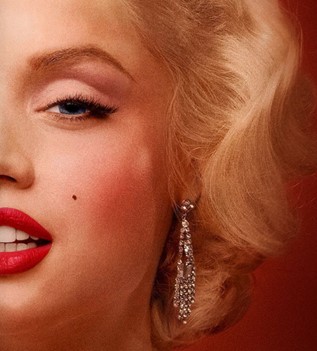Ana de Armas delivers an uncanny, transformative performance as screen legend Marilyn Monroe, but aside from outstanding aesthetics, the impressiveness of this anticipated production fades quickly as exploitation takes the lead.
Sixty years after the death of Marilyn Monroe, she lives on through a myriad of modes – countless documentaries, supposed “secret” conversations revealing the truth of her inner life and actual reason behind her mysterious death, diaries that fill bookstore shelves and renew themselves after revived interest, biographies, Netflix “tapes,” and more. While these mediums are biographical in nature, they mainly serve as cash grabs, fueling the need to keep Marilyn relevant and to reinstate her status as the blonde bombshell of the Golden Age of Hollywood.
Most recently, Blonde, released by Netflix (in their first NC-17 rating) on September 28, directed by Andrew Dominik and starring Ana de Armas as Marilyn Monroe, justifies that Marilyn needs to be laid to rest once and for all. Marilyn’s actual life has been exploited so much to the point of resorting to fiction to explain the complexity of her life and death. Based on the novel by Joyce Carol Oates, published in 2000, the film attempts to explore an imagined vision of Monroe’s life and gain an insightful look into Hollywood exploitation, capturing Monroe in vulnerable positions which propelled her to success as well as scrutiny. However, this goal of humanizing Marilyn is surely lost during extended, graphic rape scenes and abortion sequences that seem to present political positions of anti-choice and the male, pornographic gaze rather than highlighting the struggles of a woman with true, repressed talent. With this film, Marilyn’s identity has officially been stolen and misrepresented and has been made truth based on illicit rumors and studio lies. Though Netflix has scrupulously attempted to market the film as a fictional biopic, which is a contradiction in and of itself, no matter how many disclaimers they attach to film credits, ignorant knowledge and ideals about Marilyn Monroe correlate with the perversity this film conveys. If Marilyn was not owned by public domain before this film, she certainly is now.
Blonde is a perfect example of a novel not translating well to the screen or simply not being meant for it. I cannot express enough how heinous Dominik’s direction is – some scenes come off as failed, unintentional comedy, like the talking CGI fetus that is somehow fully grown as a zygote, as shown in the womb. When Marilyn suffers physical abuse from her first husband, she appears infantile, begging “Daddy” to stop, topless and bemoaning – we see this from the male’s perspective. Where Oates delves into the three personas in her novel – Norma Jeane (characterized as shy, abused, long awaiting the arrival of “Daddy” and a glimpse at some sense of family), Marilyn Monroe (the sex symbol, the movie star, the screen idol and lover of the camera), and the Blonde (a culmination of the two that serves as a concept rather than an identity a woman is attached to), Dominik appears to only explore Norma Jeane and Marilyn, weaving their stories together, based on the situations and contingencies of men rather than trusting this woman to make her own decisions and arrive at her own assertions regarding her body and her relationships. Marilyn is often put in compromising situations, but instead of attributing to Marilyn’s humanity, Dominik exploits it further, beyond the realm of public stereotype and understanding. And while the personality of Marilyn is intended to orbit around sex, this depiction is unable to distinctly separate personalities and elaborate on them the way Oates does in her novel.
In Dominik’s portrait of Norma Jeane and Marilyn, there is much crossover and a desperate attempt to make them seem like one person when in fact they are two very different women and deserve to have both personalities elaborated as such. Dominik’s interpretation lacks a middle ground – the Blonde – on which to base Norma Jeane and Marilyn – and without it, the film is whirring and results in long scenes that seemingly serve no other purpose than to speedily rush through some notable biographical facts and projects, with a particular interest in Marilyn’s supposed and confirmed affairs. Whilecreating a fictional story about the life of an artist may bring up moral concerns (which is a different topic for a different story), Dominik makes it impossible for viewers to not question these moral intentions, and in doing so, inadvertently invites the audience to pay their respects to Marilyn Monroe. Dominik’s interpretation is confusing, misogynistic, unrepresentative of Oates’s novel and further perpetuates the unrest of the legend and icon, Marilyn Monroe.
